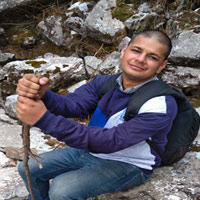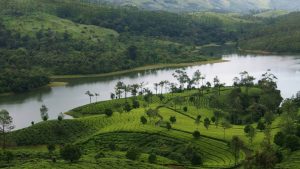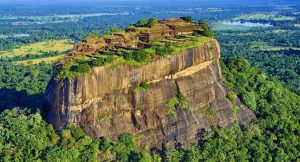Last Updated: February 19, 2025 Vishwajit Sharma
For five days in a year, all the schools, colleges and government universities remain closed. This is when the entire state of West Bengal is immersed in the celebration of Durga Puja Festival. Apart from West Bengal, it is also celebrated in other states like Assam, Tripura and Odisha. This ten day popular Hindu festival is also celebrated in Bangladesh by the Hindu community there. Other states where the festival is celebrated with gusto are Bihar and Uttar Pradesh. The festival starts on the first day with Mahalaya and ends on the tenth with Vijay Dashmi. An interesting fact about the festival, among many others, is that from the 6th to the 9th day, Goddess Durga is worshipped in a different form and depicted in a different way. Each day has its own significance. Here, we take a look at the history, religious significance, Durga Puja legends and related stories, how is it celebrated and various other aspects related to the festival. Remember though, that in 2020, it will be celebrated from October 22-26, with Mahalaya being celebrated on September 17th.
History of the Durga Puja
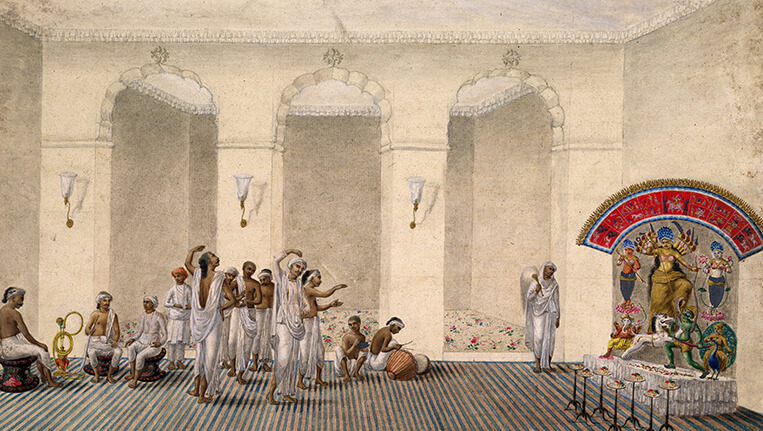
The origin of this festival is shrouded in mystery, since there are no definitive records or accounts regarding it. However, there are many theories revolving around it. According to one of them, this festival was first started by the landlords or Zamindars of Dinajpur and Malda between late 16th to early 17th centuries. It is also said that in 1790, 12 friends, belonging to Guptipara in Hooghly district district of West Bengal, collected funds from the locals to organise the first ever community puja, called the baro-yaari. This is where the tradition of community puja is believed to have originated. The first Durga Puja Celebrations in Kolkata were held in 1909.
Several scholars have their own take on the origins of the festival in West Bengal. One of them, Pranab Bandhopadhyay, believes that the worship of Durga Maa, and her more fierce avatar, Maa Kali, become especially popular with the Islamic invasion in the medieval era. Rachel Mcdermott, Professor of Asian and Middle Eastern Cultures, is of the opinion that it evolved into a social festival largely because of the persecution of Bengali Hindus in the Bengal Sultanate. Worshipping the supreme form of Mother united all of them with a spiritual and emotional bond.
Although the festival also finds a mention in the Hindu dharm granthas, there is an inconsistency regarding it. In some of the Puranas, it has been mentioned as a spring festival, while in Devi-Bhagavata Purana and Shakta Puranaas, it has been referred to as an autumn festival. Even the Indian mythology books differ regarding its origin. While the Ramayana, which is popular in North India, South India and West India depicts Lord Rama invoking Surya, the sun god, before his battle with Ravana, the Bengali version of the Ramayana depicts him invoking Goddess Durga.
Religious importance of Durga Puja Festival
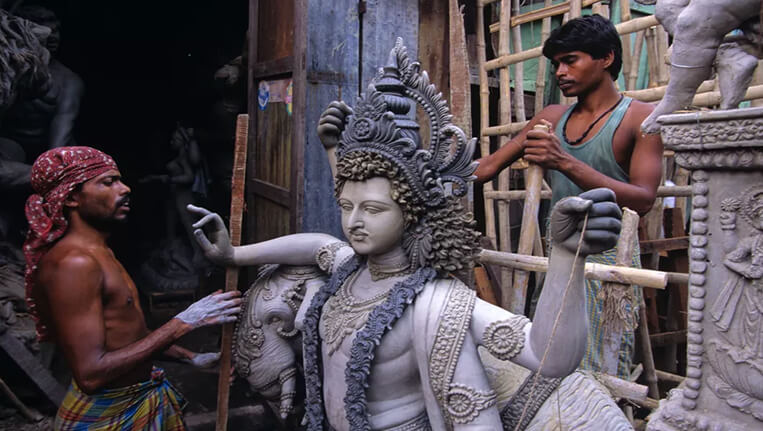
The religious significance of Durga Puja is that it is celebrated to mark the victory of Goddess Durga over the buffalo demon Mahisasura. It is symbolic of the victory of good over evil. During the course of the festival, the goddess is worshipped in various forms like Durga, Lakshmi and Saraswati. She is a symbol of love, power, courage and kindness. She is also a mother who loves her children and a warrior goddess who defeats her enemies single handed, just as she killed Mahishasura after engaging in a battle with him for 10 nights and 10 days. During the last five days, the mother is revered through various rituals and ceremonies, one of the most famous of which is the Ashtami Anjali.
This festival also has a social and economic significance. The creation of the idols, setting up of the pandals, installation of lights and other decorations and performance of rituals involve various segments of the population, from craftsmen, potters, painters and blacksmiths to artists, artisans and cleaners. This generates income for them for a short period of time, and this is especially true of people living in the rural areas. Besides that, it is an occasion for family members and distant relatives to come together and celebrate this wonderful festival together. Families and friends go pandal hopping, while every community organises its own puja. It is also a great time for the street food vendors, particularly in Kolkata, for Kolkatans love nothing more than gorging on their favorite foods while visiting the pandals.
The story of Goddess Durga

The story of Goddess Durga has always captivated our minds and imaginations. The heroic way in which she defeats and kills Mahishasura, the buffalo demon, never fails to inspire us. Here is one of the most famous legends behind the Durga Puja Festival, and why is it celebrated.
It is believed that Mahishasura was the king of the asuras and had the head of a buffalo. Even though he was an asura (demon), he was deeply devoted to Lord Brahma and performed years of difficult penance for him. Finally, Lord Brahma was impressed with the hardships he had gone through and was ready to grant him a wish. Mahishasura, drunk with power and wanting to dominate the entire earth, oceans, skies and seas, demanded immortality. He desired that he should not die at the hands of either a man or an animal. Lord Brahma immediately granted him his wish, but also told him that his death would occur at the hands of a woman.
However, Mahishasura was amused by this prediction as he believed himself to be too powerful to be killed by any woman. Drunk with power and motivated by his invincibility, he attacked Trilok (the three worlds – earth, heaven and hell). He did not even spare Indralok, the abode of Lord Indra. Even though the gods waged a war against the buffalo demon, they were unable to defeat him because he had been blessed by Lord Brahma. Helpless and frightened, they decided to seek Lord Vishnu’s help. After hearing out their problems and the grave threat facing them, he decided to create a female form. Since Lord Shiva is known as the god of destruction, all the three gods came together to create Goddess Durga, an avatar of the ultimate Shakti.
According to the story, Mahishasura and Goddess Durga were engaged in a war for about fifteen days, during which he kept changing himself into different animals and assuming different forms. Finally, when he changed himself into a buffalo, Goddess Durga stabbed him in the chest with her trident, while her lion dug its claws deep into his flesh. That was the end of the evil buffalo demon.
When is Durga Puja celebrated?

Durga Puja is known by different names in West Bengal, including Durga Pujo, Akalbodhan, Sharadiya Pujo, Maha Pujo, Maayer Pujo. In Bangladesh, it is also known as Bhagabati Puja. The popular Hindu festival is celebrated for 10 days, with the last 5 days being the most famous and widely known to those outside West Bengal. According to the traditional Hindu calendar, it is celebrated in the month of Ashvin, which, in the Gregorian calendar, falls between September-October. Ashvin is the seventh month of the Hindu calendar.
Rituals & Ceremonies surrounding Durga Puja Festival

Durga Puja starts with Mahalaya, and is followed by Shasthi, Shaptami, Ashtami, Navami and Dashami, on the 6th, 7th, 8th, 9th and 10th days respectively.
Mahalaya
The celebrations of Maa Durga begin on Mahalaya which occurs on Amavasya. It is held on the last day of the dark fortnight in the month of Ashvin, according to the traditional Hindu calendar. This day is marked by preparing for the arrival of Goddess Durga on earth along with her family consisting of Lord Shiva, Lord Ganesha, Goddess Saraswati and Lord Kartikeya. A famous legend associated with Mahalaya states that Goddess Durga arrived on earth to destroy the demon buffalo, Mahishasura. The demon king Mahishasura had been granted a boon according to which, he could not be killed by any man or animal. Shakti, the ultimate female power, thereupon took the form of Goddess Durga to kill the demon.
On this day, Mahisasuramardini, a radio program is broadcast in the early morning. About one and a half hours long, it consists of recitation from the verses of Sri Sri Chandi or Durga Saptashati. It is recited by the soothing voice of Birendra Krishna Bhadra, and so powerful yet sonorous is his voice that one listening to it is immediately enveloped by a spiritual aura. Since the program is held at daybreak, most of the Bengali households wake up early to listen to this powerful program.
Shasti – 6th Day
Shasti is the 6th day of this wonderful festival, and it is on this day that the pandals are inaugurated. On this day, Goddess Durga is worshipped as Katyayani and adorned with weapons which were gifted to her by different gods to kill the buffalo demon Mahishasura.
Saptami – 7th Day
Saptami is celebrated on the 7th day, and is marked by the bathing of the goddess, selection of the priest and recitation of elaborate prayers (aarti). On this day, a group of nine plants called Nabapatrika are tied together as a way to invoke Goddess Durga. These nine plants are believed to represent the nine manifestations of Goddess Durga. During the early hours of the morning of the morning before sunrise, these plants are immersed in the waters of River Ganga.
Ashtami – 8th Day
Ashtami is celebrated on the 8th day, and is considered to be an immensely important day. You may miss other kinds of celebrations, but you should never miss the Ashtami anjali. The puja which is offered on this day is meant to prepare the Goddess for her battle against Mahishasura, the buffalo demon. The famous Sandhi Puja, which is also offered on this day, is performed at the precise moment when Ashatmi ends and Navami begins. In fact, the last 24 minutes of Ashtami, and the first 24 minutes of Navami, are regarded as Sandhikhan. This is the moment when Goddess Durga finally killed Chando and Munda, the two allies of Mahishasura who attacked Goddess Durga from behind. The offerings on this day are as grand as the occasion itself. Besides 108 lotuses, 108 earthen oil lamps, single whole fruit, hibiscus flowers, saree, uncooked grains, jewellery, bel leaves and a garland of 108 bel leaves are offered to the Goddess. Even though every family has its own unique way of offering to the Goddess, what is always found in each household is the 108 lamps, lotuses and bel leaves.
Navami – 9th Day
On the nine day of the Durga Puja Festival in India, Goddess Durga is revered as a girl child. It is marked by the Kumari Puja, where little girls are adorned in jewellery and make up which resembles the Goddess. All the other ceremonies, from blowing the conch to swinging the silver hand fans, are observed as usual. It is an interesting sight to observe, for not often do you come across such a unique form of celebration.
Dashami – 9th Day
Finally, you have Dashmi, the last day of the festival. Although it is as important as any other day, the people are overcome with emotion as they bid farewell to their beloved Mother Durga. Popularly known as Vijaya Dashmi, it is the day when the goddess reunites with her husband, Lord Shiva, on Mount Kailash. People, especially the ladies, get together to bid farewell to Goddess Durga, with vermillion and an assortment of sweets. This is followed by the Bhashaan, where the idol of Durga Maa is taken to the Holy Ganges and immersed, symbolically representing her return to Lord Shiva.
Interesting facts about Durga Puja Festival
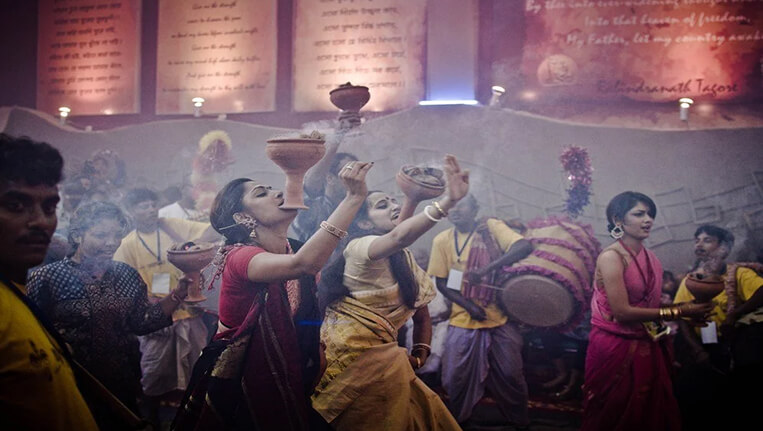
Durga Puja is a major festival of Hinduism which carries immense religious and social significance. There are many interesting facts about Durga Puja Festival which are worth knowing. Here, we tell you some of them.
- There is a tradition associated with Durga Puja, according to which, the idol of the goddess is made from clay, while the other gods and goddesses accompanying her are called ek chala (one cover). The eyes of the idol hold great significance and should be only be painted in the presence of the sculptor. This process is called Chokkhu daan (offering the eyes), and the sculptor who carries it out is overcome by emotions, as he spends months creating and perfecting the idol.
- The clay that is used for creating the idols of Goddess Durga is collected from the banks of River Hoogly, as the Ganga is known in West Bengal. The clay should always be mixed with soil collected from places known as nishiddho palli, or forbidden areas. One of these is the house of a prostitute. Tradition dictates that the priest should go to the house of a prostitute or a brothel and beg for the punya matti (pure soil). This tradition is followed to emphasize the message that Maa Durga does not discriminate between her children, and that everybody is equal before her. It is believed that the soil collected from the house of a prostitute, or brothel, is pure and virtuous because the people who visit them leave their purity and virtue outside the door.
- The vehicle that Goddess Durga chooses to arrive on earth carries enormous significance. The common vehicles of Maa Durga are lion, elephant, boat, horse and palanquin. The vehicle on which she arrives is always different from the vehicle in which she leaves.
- Among the many fascinating things to watch out for during the Durga Puja celebrations in India, one is the Dhunuchi Nritya, which is a dance performed with dhunuchi (a Bengali incense burner used for performing aarti). Best dance competitions are also organised. During the course of these competitions, some of the performers dance with three dhunuchis, with one being held in their teeth. It requires great skill, coordination, flexibility and stamina.
- If you visit Kolkata, West Bengal or any other place when the festivities are in full swing, do not forget to taste the khichdi, which is the bhog offered to the goddess. Although you may have had khichuri many times before, the one served during the course of this festival has a distinct flavour.
- Idols of different shapes and sizes are available in the market throughout the time this festival is held. The oldest of all is the Daaker Saaj, and has an interesting history behind it. Beaten silver, or rangta, which was first used to decorate the idols, was imported from Germany. It was delivered via postal service, and thenceforth, came to be known as Dakker Saaj, since Daak means letters in Bengali.
- Another interesting ceremony observed which is observed on Saptami, the seventh day, is the Kola Bou, or the tree bride. A banana plant, which is believed to symbolise the wife of Lord Ganesha, is decorated and bathed in the morning as a part of the ritual and placed on the right side of Maa Durga’s son, Lord Ganesha.
Most famous Durga Puja Pandals in Kolkata

It’s Durga Puja, and what better thing to do than to go pandal hopping. It is so much fun because each pandal differs from the next in various ways, including theme, idols and layout. Some are famous because of their enormous size, while others attract crowds because of their theme or decoration. Here are the most famous Durga Puja Pandals in Kolkata.
- College Square Sarbojanin Durgotsav
- Ekdalia Evergreen Durga Puja Club
- Suruchi Sangha
- Bagbazar Sarbojanin Durgotsav
- Badamtala Ashar Sangha
- Santosh Mitra Square
- Hindustan Park
- Jodhpur Park
- Bosepukur Sitala Mandir
- Badamtala Ashar Sangha
- Kumartuli Park
- Sreebhumi Sporting Club
- Chetla Agrani Chetla, Chetla
- Santoshpur Lake Pally, Santohspur
- Dum Dum Park Tarun Sangha, Dum Dum
Let’s see how other states celebrate Durga Puja
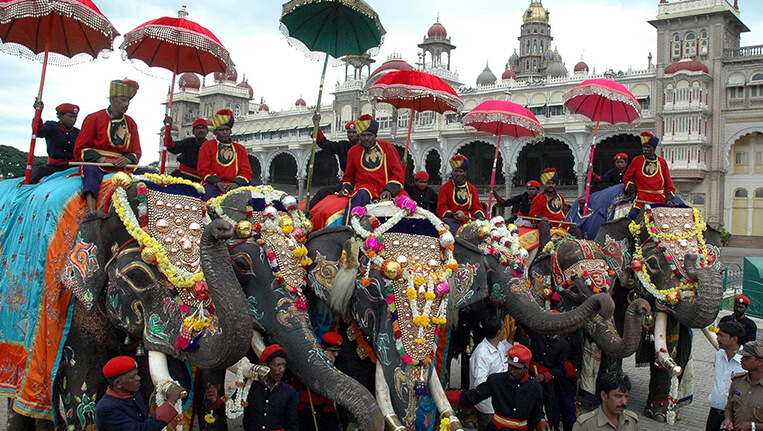
Apart from West Bengal, Assam, Bihar, Odisha and Varanasi in Uttar Pradesh, where Durga Puja is celebrated more or less the same way, other states in India celebrate it in different ways. Here’s bringing you some of them.
- Gujarat: During this time Gujarat celebrates danidya, which is famous for its dandiya and garba dance.
- Tamil Nadu: In Tamil Nadu, they worship Goddesses Durga, Lamxi and Saraswati, and dedicate a day to each of them. A fascinating ritual is golu, where dolls and figurines are displayed. They are based on various themes.
- Andhra Pradesh: The people of Andhra Pradesh celebrate Bathukamma Panduga, in which nine days are dedicated to Maha Gauri, the goddess believed to represent womanhood. Women prepare flower stacks in the traditional style, which, at the end of the festival, are set afloat on a lake or the nearest water body.
- Kerala: Keralites place a lot of value on education, and the presiding deity during Durga Puja here is Goddess Saraswati. During the last three days, books are placed next to the statue of Goddess Saraswati in their homes.
- Navratri: Most of North India celebrates Navratri during this time. Fasting is observed on the first seven days. During the nights, jagrans (gathering of devotees to sing religious songs). On Navami, the fast is broken by inviting nine young girls and offering them food, money and other gifts. The girls are believed to be the representation of kanjak (the nine different avatars of Goddess Shakti).
- Himachal Pradesh: Himachal Pradesh worships Maa Durga in a completely different way. The celebrations are held on the tenth day of Navratri and Durga Puja. It is known as Kullu Dussehra and is held to celebrate the return of Lord Rama to Ayodhya. It is marked by social gatherings, festivities and the worship of Goddess Durga.
- Maharashtra: The celebrations in Maharashtra are similar to that of Gujarat in many ways. It is considered an auspicious time to start something new like purchasing of property or finalizing business deals.
- Karnataka: In Karnataka, the celebration of Maa Durga is known as Nadahabba. Its celebrations are held exactly as they were in 1610 by the glorious Vijayanagara dynasty. On Dashami, bedecked elephants are paraded on the streets while fairs and exhibitions are held throughout the state.
Popular Durga Temples in India
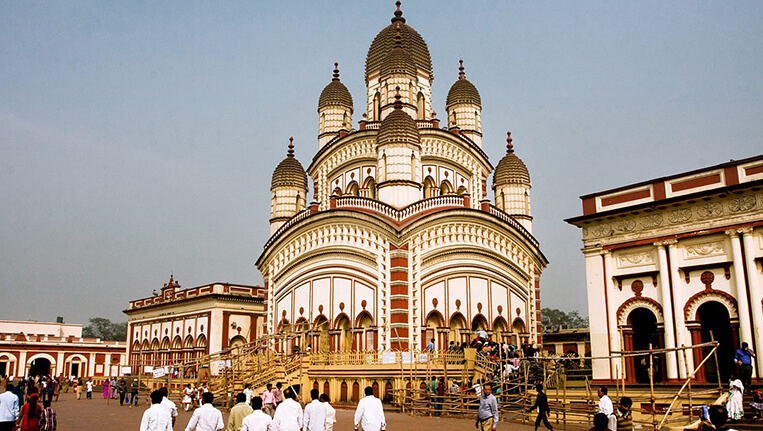
Goddess Durga is an avatar of Shakti, an embodiment of ultimate power, energy, ability, strength, and indeed, the entire cosmic energy. There are numerous temples across the country which have been built in her honour. These are some of the popular Durga Temples in India which you can visit and seek her blessing.
- Vaishno Devi Temple, Jammu
- Jwala Ji Temple, Himachal Pradesh
- Mansa Devi Temple, Uttarakhand
- Durga Temple, Uttar Pradesh
- Devi Patan Temple, Uttar Pradesh
- Maa Bamleshwari Temple, Chhattisgarh
- Dakshineswar Kali Temple, West Bengal
- Kalka Devi Temple, Delhi
- Karni Mata Temple, Rajasthan
- Durga Parameshwari Temple, Karnataka
- Kanaka Durga Temple, Andhra Pradesh
- Bhagwati Amman Temple, Kerala
Durga Puja Festival Dates 2020

The dates for the Durga Puja Festival 2020 are mentioned below. Be a part of the celebrations and join others in celebrating the glory of Goddess Durga.
- 17 September, Thursday: Mahalaya
- 21 October, Monday: Maha Panchami
- 22 October, Tuesday: Maha Shasthi
- 23 October, Wednesday: Maha Saptami
- 24 October, Thursday: Maha Ashtami
- 25 October, Friday: Maha Navami
- 26 October, Saturday: Vijaya Dashami
So, now you have all the important information regarding Durga Puja Festival 2020, including the legends behind it, rituals & ceremonies, most famous pandals, dates and interesting facts. Why do you look forward to the celebration of Maa Durga and what do you enjoy most about it? How many of these most popular Durga Puja Pandal in Kolkata have you visited and which are your favorite ones? Read the blog and let us know.
Thumbnail Image Credit: https://bit.ly/34aTxbE
Published: 29 Aug, 2019
Writing, for me, is an artistic expression of the countless thoughts flooding my mind. For now, travel content writing is what keeps me going! In my spare time, I like nothing better than immersing myself in a book, along with a cuppa! A classic movie helps too! I define traveling as a process of self-discovery. Hailing from Darjeeling, my ultimate desire is to escape to the hills, with the mountain air and solitude as my constant companions!



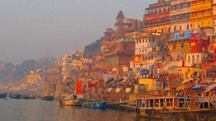 15 Nights / 16 Days
15 Nights / 16 Days 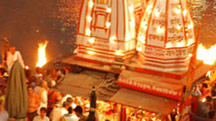 2 Nights / 3 Days
2 Nights / 3 Days  13 Nights / 14 Days
13 Nights / 14 Days  16 Nights / 17 Days
16 Nights / 17 Days 



 2 Nights / 3 Days
2 Nights / 3 Days 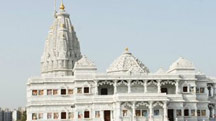 5 Nights / 6 Days
5 Nights / 6 Days  5 Nights / 6 Days
5 Nights / 6 Days 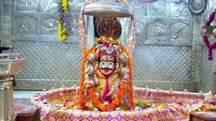 23 Nights / 24 Days
23 Nights / 24 Days 





 7 Nights / 8 Days
7 Nights / 8 Days  3 Nights / 4 Days
3 Nights / 4 Days  1 Nights / 2 Days
1 Nights / 2 Days  6 Nights / 7 Days
6 Nights / 7 Days 